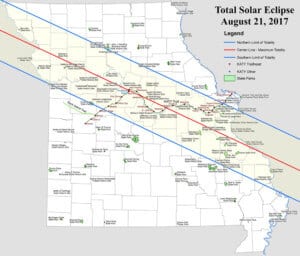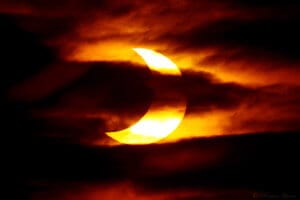In case you hadn’t heard, something pretty incredible is happening August 21. The universe is giving the St. Louis area exclusive front row seats to one of the biggest shows around — the Great Solar Eclipse 2017 — and we want you to be prepared.
The Great American Solar Eclipse, or Great Solar Eclipse, will darken skies from Oregon to South Carolina along a 70-mile-wide “path of totality,” and Missouri is considered to be center-stage. (Check out this New York Times article about the Show-Me State.) It may sound like something out of a sci-fi movie, but although it is rare, this stellar situation is completely natural.

It’s the first total solar eclipse to pass only over the United States since 1776, and it will be making its way across north central Missouri. The last time a path of totality of an eclipse went through our state was over a century and a half ago, on August 7, 1869 — and even then, it only passed over the northeast corner.
St. Louis will be bisected by the northernmost border of the path of totality of the Great Solar Eclipse 2017, but from St. Joseph to DeSoto and all points in between, towns and cities in its path are planning viewing parties and special events. It’s a fun and exciting time, but it’s also important that you protect your eyes in the process.
You may recall making pinhole projectors in school to view partial eclipses in years gone by. If you do, you probably also vividly recall warnings from adults that you’d go blind if you looked at the eclipse directly. Those warnings really were — and still are — founded in sound science.
Although total blindness from looking at the Great Solar Eclipse 2017 is unlikely, there is a condition called solar retinopathy that occurs when bright light from the sun floods the retina on the back of the eyeball. The damage that can be caused is painless, so you would likely not realize you are damaging your vision until it’s too late.

During an eclipse, the only safe way to look at the phenomenon is through special-purpose solar filters, such as eclipse glasses or handheld solar viewers.
To-date, there are four manufacturers whose eclipse glasses and handheld solar viewers meet the ISO 12312-2 international standard for such products: Rainbow Symphony, American Paper Optics, and Thousand Oaks Optical. Be sure to wear a pair of certified solar viewing glasses when viewing the Great Solar Eclipse of 2017.
Brinton Vision recently partnered with the Rockwood School District to provide solar viewing glasses for every child in the district so that students can capture memories of the Great Solar Eclipse safely. Knowing we will help these children create memories makes us smile, and we’re happy to give back to our community in such a positive, meaningful way.
The next Great American Solar Eclipse won’t come around until April 2024. When it does, it will be fun to reminisce over memories of this year’s excitement! Just be sure to wear protective eyewear and preserve your vision so that you can enjoy this and many more events for years to come.
Fun Fact:

When the last American solar eclipse passed through in 1869, it likely saved the lives of astronomer and explorer George Davidson and his research party. In 1869, the U.S. government was brokering a deal to purchase Alaska from Russia. Davidson, who held a doctorate in astronomy, was charged with documenting the forests, mountains, lakes, and other geographical formations.
In August, they entered the Chilkat Valley. Other white explorers had arrived earlier, and most had not been respectful of the resources or people who were living there. Chilkat people were ready to defend their land and tribe, and Davidson was warned that the Chilkat would be hostile when he arrived.
August 6, in a tense confrontation with Chilkat leaders, Davidson explained that he meant the tribe no harm. Through an interpreter, he explained that he was there to observe a total eclipse of the sun that was to occur the following day. The Chilkat scoffed at his outrageous claim, but they left Davidson alone that night.
The next day, the midday sky grew dark. The sun over the Chilkat Valley disappeared behind the moon, just as Davidson said it would. This frightening display of power terrified the Chilkat, who undoubtedly believed Davidson had somehow controlled the sun. Instead of attacking Davidson and his team, they fled into the woods and let them be throughout the remainder of their expedition.
Davidson’s documentation was later presented to Congressional committees and is said to have been an integral part of passage of the bill to acquire Alaska. He also later founded the Davidson Observatory in California and became a charter member of the Sierra Club. Mt. Davidson in San Francisco is among the many geographical formations named for him. Had it not been for his understanding of solar and lunar cycles, what we now understand about space and our earth could have turned out much differently.
Photo credit for featured image: Kosmas Gazeas (2011)
 St. Louis LASIK surgeon Dr. Jason P. Brinton, MD is an internationally recognized specialist in the field of refractive surgery. He is a graduate of Harvard College, earned his medical doctorate from the Harvard Medical School, and is board certified by the American Board of Ophthalmology. He has been inducted to America’s Top Ophthalmologists by the Consumer Research Council of America, Leading Physicians of the World by the International Association of Healthcare Professionals, and Top Doctors in America by Castle Connolly. In 2015, he received global recognition as the recipient of the Visian ICL Young Ophthalmologist Award in Barcelona, Spain, and in 2016 was named Ocular Surgery News’ Premier Surgeon 300 Innovators in Refractive Cataract Surgery. He is a dedicated husband, father of four beautiful children, and is passionate about his life, his work, and service to others.
St. Louis LASIK surgeon Dr. Jason P. Brinton, MD is an internationally recognized specialist in the field of refractive surgery. He is a graduate of Harvard College, earned his medical doctorate from the Harvard Medical School, and is board certified by the American Board of Ophthalmology. He has been inducted to America’s Top Ophthalmologists by the Consumer Research Council of America, Leading Physicians of the World by the International Association of Healthcare Professionals, and Top Doctors in America by Castle Connolly. In 2015, he received global recognition as the recipient of the Visian ICL Young Ophthalmologist Award in Barcelona, Spain, and in 2016 was named Ocular Surgery News’ Premier Surgeon 300 Innovators in Refractive Cataract Surgery. He is a dedicated husband, father of four beautiful children, and is passionate about his life, his work, and service to others.

